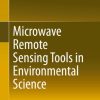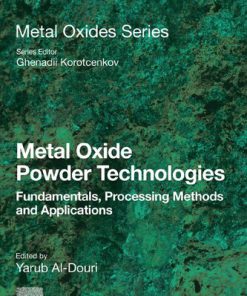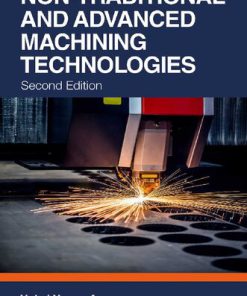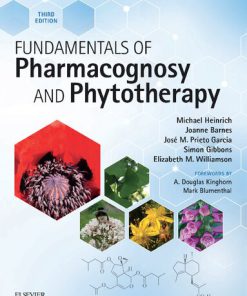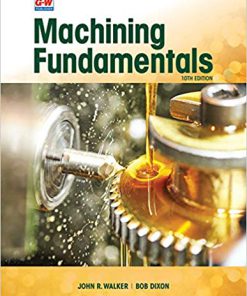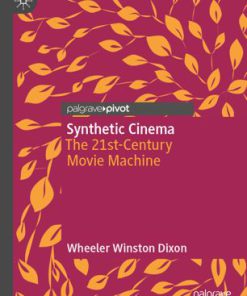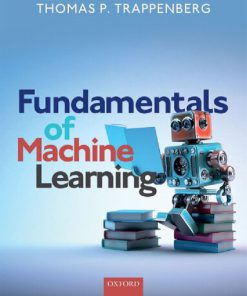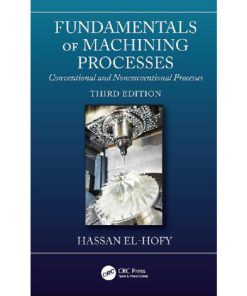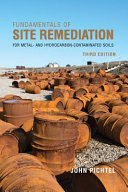Fundamentals of Metal Machining and Machine Tools 3rd Edition by Winston Knight, Geoffrey Boothroyd 1498732642 9781498732642
$50.00 Original price was: $50.00.$25.00Current price is: $25.00.
Fundamentals of Metal Machining and Machine Tools 3rd Edition by Winston A. Knight, Geoffrey Boothroyd – Ebook PDF Instant Download/DeliveryISBN: 1498732642, 9781498732642
Full download Fundamentals of Metal Machining and Machine Tools 3rd Edition after payment.
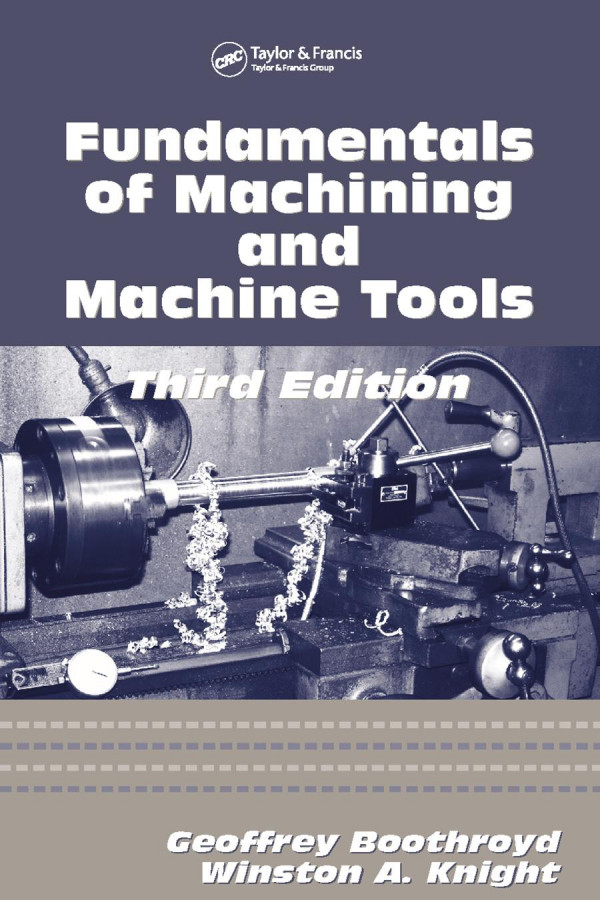
Product details:
ISBN-10 : 1498732642
ISBN-13 : 9781498732642
Author: Winston A. Knight, Geoffrey Boothroyd
Reflecting changes in machining practice, Fundamentals of Machining and Machine Tools, Third Edition emphasizes the economics of machining processes and design for machining. This edition includes new material on super-hard cutting tool materials, tool geometries, and surface coatings. It describes recent developments in high-speed machining, hard machining, and cutting fluid applications such as dry and minimum-quantity lubrication machining. It also presents analytical methods that outline the limitations of various approaches. This edition features expanded information on tool geometries for chip breaking and control as well as improvements in cost modeling of machining processes.
Fundamentals of Metal Machining and Machine Tools 3rd table of contents:
1 Machine Tools and Machining Operations
1.1 INTRODUCTION
FIGURE 1.1 Generation of a cylindrical surface in horizontal boring.
1.2 GENERATING MOTIONS OF MACHINE TOOLS
FIGURE 1.2 Coordinate system for specification of machine tool motions. (a) Motions of the tool; (b) motions of the workpiece.
1.3 MACHINES USING SINGLE-POINT TOOLS
1.3.1 ENGINE LATHE (CENTER LATHE)
FIGURE 1.3 (a) An engine lathe; (b) cylindrical turning on an engine lathe.
1.3.2 SINGLE-POINT TOOLS
FIGURE 1.4 Typical single-point tool.
FIGURE 1.5 Resultant cutting motion in cylindrical turning.
FIGURE 1.6 Single-point tool operation, where ac = af sinr.
1.3.3 TYPICAL LATHE OPERATIONS
FIGURE 1.7 Lathe operations. (a) Cylindrical turning; (b) facing; (c) boring; (d) external threading; (e) parting and cutoff.
1.3.4 WORK AND TOOL HOLDING IN AN ENGINE LATHE
FIGURE 1.8 Lathe work holding using chucks. (a) Three-jaw (self-centering) chuck; (b) independent four-jaw chuck.
FIGURE 1.9 Work holding when turning between centers.
1.3.5 OTHER TYPES OF LATHES
FIGURE 1.10 Typical lathe tool post and compound rest.
FIGURE 1.11 Four-way tool post.
1.3.6 VERTICAL-BORING MACHINE (VERTICAL BORER)
FIGURE 1.12 Facing on a vertical-boring machine.
FIGURE 1.13 Work holding in vertical boring machines.
1.3.7 HORIZONTAL-BORING MACHINE (HORIZONTAL BORER)
FIGURE 1.14 Boring on a horizontal-boring machine.
1.3.8 SHAPING MACHINE (SHAPER)
FIGURE 1.15 Facing on a horizontal-boring machine.
FIGURE 1.16 Work holding methods for machine tables having T slots.
FIGURE 1.17 Production of flat surfaces on a shaper.
1.3.9 PLANING MACHINE (PLANER)
FIGURE 1.18 Quick-return mechanism for a mechanical shaper.
1.4 MACHINES USING MULTIPOINT TOOLS
1.4.1 MULTIPOINT TOOLS
FIGURE 1.19 Tool and work holding on a shaper.
1.4.2 DRILLING MACHINE (DRILL PRESS)
FIGURE 1.20 Shaping operations. (a) Horizontal surface; (b) vertical surface; (c) inclined surface.
FIGURE 1.21 Production of flat surfaces on a planer.
FIGURE 1.22 Drilling on a drill press.
FIGURE 1.23 Twist drill, where ac = af sin r.
FIGURE 1.24 Releasing a taper-shank tool.
FIGURE 1.25 Some drill-press operations. (a) Center drilling; (b) reaming; (c) spot-facing.
1.4.3 HORIZONTAL-MILLING MACHINE (HORIZONTAL MILLER)
FIGURE 1.26 Radial-arm drill.
FIGURE 1.27 Slab milling on a knee-type horizontal-milling machine.
FIGURE 1.28 Geometry of a slab-milling operation, where
FIGURE 1.29 Relative motion between a slab-milling cutter and the workpiece during machining time.
FIGURE 1.30 Some horizontal milling operations. (a) Form cutting; (b) slotting; (c) straddle milling; (d) angular milling.
1.4.4 VERTICAL-MILLING MACHINE (VERTICAL MILLER)
FIGURE 1.31 Tool holding in horizontal milling.
FIGURE 1.32 Face milling on a knee-type vertical milling machine.
FIGURE 1.33 Geometry of face milling, where acmax = (vf/Nnt).
FIGURE 1.34 Relative motion between face-milling cutter and the workpiece during machining time.
FIGURE 1.35 Some vertical-milling machine operations. (a) Horizontal surface; (b) slot; (c) dovetail; (d) T slot.
1.4.5 BROACHING MACHINE (BROACHER)
FIGURE 1.36 Tool holding for a shell end mill.
FIGURE 1.37 Broaching on a vertical-broaching machine, where ac = f.
FIGURE 1.38 Methods of broaching a hole. (a) Pull broach; (b) push broach.
1.4.6 TAPS AND DIES
FIGURE 1.39 Tapping.
1.5 MACHINES USING ABRASIVE WHEELS
1.5.1 ABRASIVE WHEELS
FIGURE 1.40 Common shapes of abrasive wheels. (a) Cylindrical; (b) disk; (c) cup.
1.5.2 HORIZONTAL-SPINDLE SURFACE-GRINDING MACHINE (HORIZONTAL-SPINDLE SURFACE GRINDER)
FIGURE 1.41 Surface grinding on a horizontal-spindle surface grinder.
FIGURE 1.42 Horizontal-spindle surface-grinding operations. (a) Traverse grinding; (b) plunge grinding.
1.5.3 VERTICAL-SPINDLE SURFACE-GRINDING MACHINE (VERTICAL-SPINDLE SURFACE GRINDER)
FIGURE 1.43 Tool and work holding in surface grinding. (a) Tool holding; (b) work holding.
FIGURE 1.44 Surface grinding on a vertical-spindle surface grinder.
1.5.4 CYLINDRICAL-GRINDING MACHINE (CYLINDRICAL GRINDER)
FIGURE 1.45 Cylindrical grinding.
FIGURE 1.46 Cylindrical-grinding operations. (a) Traverse grinding; (b) plunge grinding.
1.5.5 INTERNAL-GRINDING MACHINE (INTERNAL GRINDER)
FIGURE 1.47 Internal grinding.
FIGURE 1.48 Internal-grinding operations. (a) Transverse grinding; (b) plunge grinding.
1.5.6 CENTERLESS GRINDING MACHINES
FIGURE 1.49 External centerless grinding.
FIGURE 1.50 Internal centerless grinding.
1.6 SUMMARY OF MACHINE TOOL CHARACTERISTICS AND MACHINING EQUATIONS
TABLE 1.1 Typical Characteristics of Machines Using Single-Point Tools
TABLE 1.2 Typical Characteristics of Machines Using Multipoint Tools
TABLE 1.3 Typical Characteristics of Machines Using Multipoint Tools
TABLE 1.4 Summary of Equations for Cutting Operations
TABLE 1.5 Summary of Equations for Cutting Operations
FIGURE 1.51 Typical characteristics of machine tools having reciprocating motion, where nr = frequency of reciprocation, lw = length of workpiece, v = cutting speed, and vtrav = traverse speed (for grinders).
FIGURE 1.52 Approximate values of the specific cutting energy ps for various materials and operations.
PROBLEMS
REFERENCE
2 Mechanics of Metal Cutting
2.1 INTRODUCTION
FIGURE 2.1 Models of the cutting process. (a) Present-day model; (b) earlier misconception.
2.2 TERMS AND DEFINITIONS
FIGURE 2.2 Orthogonal and oblique cutting. (a) Orthogonal cutting; (b) oblique cutting.
FIGURE 2.3 Terms used in metal cutting. (a) Positive rake; (b) negative rake.
2.3 CHIP FORMATION
FIGURE 2.4 A quick-stopping device.
2.3.1 CONTINUOUS CHIP
FIGURE 2.5 Continuous chip.
FIGURE 2.6 Continuous chip with built-up edge.
FIGURE 2.7 Discontinuous chip.
2.3.2 CONTINUOUS CHIP WITH BUILT-UP EDGE
2.3.3 DISCONTINUOUS CHIP
2.3.4 OTHER TYPES OF CHIP FORMATION
FIGURE 2.8 Segmented chip formation. (a) Partial segmentation; (b) complete segmentation.
2.4 THE FORCES ACTING ON THE CUTTING TOOL AND THEIR MEASUREMENT
FIGURE 2.9 Speed ranges for segmented chip formation for AISI 4340 steel with different hardness values.
FIGURE 2.10 Effect of cutting speed on the separation of chip segments.
FIGURE 2.11 Cutting (Fc) and thrust (Ft) components of resultant tool force (Fr).
FIGURE 2.12 Simple two-component cutting force dynamometer for use on a lathe, where dial gauge A gives a measure of Fc, and dial gauge B gives a measure of Ft.
2.5 SPECIFIC CUTTING ENERGY
FIGURE 2.13 Effect of cutting speed and undeformed chip thickness on specific cutting energy, where ps = specific cutting energy, v = cutting speed, and ac = undeformed chip thickness and the material is mild steel, the normal rake is 10 degrees. and the width of the chip is 1.25 mm.
2.6 PLOWING FORCE AND THE “SIZE EFFECT”
FIGURE 2.14 Contact regions on a cutting tool, where Fr = resultant tool force, F’r = force required to remove chip, and Fp = plowing force acting on the tool edge and work-tool interface region.
FIGURE 2.15 Effect of maximum undeformed chip thickness acmax on specific cutting energy ps during slab milling, where the material is steel, 57 ton/in.2, UTS.
2.7 THE APPARENT MEAN SHEAR STRENGTH OF THE WORK MATERIAL
FIGURE 2.16 Shear-plane model of continuous chip formation, where Fr = resultant tool force, Fc = cutting force, Ft = thrust force, Fs = shear force on shear plane, φ = shear angle, γne = working normal rake, ac = undeformed chip thickness, ao = chip thickness, Ac = cross-sectional area of uncut chip, and ls = length of shear plane.
2.8 CHIP THICKNESS
2.8.1 THEORY OF ERNST AND MERCHANT
FIGURE 2.17 Force diagram for orthogonal cutting, where Fr = resultant tool force, Fc = cutting force, Ft = thrust force, Fs = shear force on shear plane, Ff = frictional force on tool face, Fn = normal force on tool face, φ = shear angle, γne = working normal rake, β = mean friction angle on tool face, ac = undeformed chip thickness, and ao = chip thickness.
FIGURE 2.18 Dependence of τs and σs assumed in Merchant’s second theory.
2.8.2 THEORY OF LEE AND SHAFFER
FIGURE 2.19 Stress-strain curve for a rigid-plastic material.
FIGURE 2.20 Lee and Shaffer’s slip-line field for orthogonal cutting, where Fr = resultant tool force, φ = shear angle, γne = working normal rake, β = mean friction angle on tool face, ac = undeformed chip thickness, and ao = chip thickness.
2.8.3 EXPERIMENTAL EVIDENCE
FIGURE 2.21 Comparison of theoretical and experimental shear-angle relationships for orthogonal metal cutting, where φ = shear angle, γne = working normal rake, and β = mean friction angle on tool face.
FIGURE 2.22 Experimental shear angle results; top line represents Merchant’s relationship and the bottom line represents Lee and Shaffer’s relationship.
FIGURE 2.23 Model of an orthogonal cutting process.
2.9 FRICTION IN METAL CUTTING
FIGURE 2.24 Suggested frictional behavior for a “soft” slider, where Ff = frictional force, Fn = normal force, Ar = real area of contact, Aa = apparent area of contact, and τf = shear strength of softer metal. (a) Sliding friction; (b) sticking friction.
FIGURE 2.25 Model of chip-tool friction in orthogonal cutting, where σfmax = maximum normal stress, τf = normal stress, τf = shear stress, τst = shear strength of chip material in the sticking region, lf = chip-tool contact length, and lst = length of sticking contact length.
2.10 ANALYTICAL MODELING OF MACHINING OPERATIONS
2.10.1 MECHANISTIC MODELING OF MACHINING
FIGURE 2.26 Oblique machining process, where v = cutting velocity, γne = working normal rake, and λγ = chip flow angle.
2.10.2 SLIP LINE FIELD ANALYSIS
FIGURE 2.27 Approximate representations of complex cutting edges as a series of elemental oblique cutting edges.
2.10.3 PREDICTIVE MODELS FOR ORTHOGONAL CUTTING
FIGURE 2.28 Three possible slip line field configurations for orthogonal cutting, with rake angle γne = 50 and friction factor m = 0.9: (a) Lee and Shafer model; Kudo model; Dewhurst model. The line bb’ represents the distortion of the line aa’ after chip formation.
FIGURE 2.29 Predictive model for orthogonal cutting, where Fr = resultant tool force, Fc = cutting force, Ft = thrust force, Fs = shear force on shear plane, Ff = frictional force on tool face, Fn = normal force on tool face, φ = shear angle, γne = working normal rake, β = mean friction angle on tool face, ac = undeformed chip thickness, ao = chip thickness, v = cutting speed, vs = shearing velocity on the shear plane, and v0 = chip velocity.
FIGURE 2.30 Comparison of predicted and experimental results from model shown in Figure 2.29. (a) Shear flow stress and shear angle against undeformed chip thickness; (b) cutting forces and shear angle variation with cutting speed.
2.10.4 FINITE ELEMENT ANALYSIS
FIGURE 2.31 Approaches to finite element modeling of machining. (a) Eulerian approach, material flows through a fixed element mesh; (b) Lagrangian approach, elements move with material and distort and rotate with position.
2.10.5 MODELING OF MATERIAL PROPERTIES
PROBLEMS
REFERENCES
3 Temperatures in Metal Cutting
3.1 HEAT GENERATION IN METAL CUTTING
FIGURE 3.1 Experimental tool life and tool temperature results for machining heat-resistant steel with a P10 carbide tool.
FIGURE 3.2 Generation of heat in orthogonal cutting.
3.2 HEAT TRANSFER IN A MOVING MATERIAL
FIGURE 3.3 Element through which heated material flows.
FIGURE 3.4 Temperature distribution in a fast-moving material for a one-dimensional case, where Θ5 = P/cva.
3.3 TEMPERATURE DISTRIBUTION IN METAL CUTTING
FIGURE 3.5 Temperature distribution in workpiece and chip during orthogonal cutting (obtained from an infrared photograph) for free-cutting mild steel where the cutting speed is 75 ft/min (0.38 m/s), the width of cut is 0.25 in. (6.35 mm), the working normal rake is 30 degrees, and the workpiece temperature is 611°C.
3.3.1 TEMPERATURES IN THE PRIMARY DEFORMATION ZONE
FIGURE 3.6 Idealized model of cutting process employed in theoretical work on cutting temperatures.
3.3.2 TEMPERATURES IN THE SECONDARY DEFORMATION ZONE
3.3.3 EXAMPLE
FIGURE 3.7 Effect of Rtan φ on division of shear-zone heat between chip and workpiece, where Γ = the proportion of shear zone heat conducted into the workpiece, R = thermal number, and φ = the shear angle.
FIGURE 3.8 Revised boundary condition for chip.
FIGURE 3.9 Effect of width of secondary deformation zone on chip temperatures, where R = thermal number, l0a0 = chip-tool contact length, w0a0 = width of secondary deformation zone, Θm = maximum temperature rise in the chip, and Θf = mean temperature rise in chip.
FIGURE 3.10 Grain deformation in chip cross section.
FIGURE 3.11 Effect of cutting speed on cutting temperatures (theoretical).
3.3.4 EFFECT OF CUTTING SPEED ON TEMPERATURES
3.3.5 PREDICTION OF TEMPERATURE DISTRIBUTIONS IN MACHINING
FIGURE 3.12 Comparison of experimental peak cutting temperatures with those predicted by finite element modeling using different material property models.
3.4 THE MEASUREMENT OF CUTTING TEMPERATURES
3.4.1 WORK-TOOL THERMOCOUPLE
FIGURE 3.13 Work-tool thermocouple circuit.
3.4.2 DIRECT THERMOCOUPLE MEASUREMENTS
FIGURE 3.14 Arrangement for measurement of workpiece temperatures using the thermocouple technique.
3.4.3 RADIATION METHODS
3.4.4 HARDNESS AND MICROSTRUCTURE CHANGES IN STEEL TOOLS
PROBLEMS
REFERENCES
4 Tool Life and Tool Materials
4.1 INTRODUCTION
4.2 PROGRESSIVE TOOL WEAR
4.3 FORMS OF WEAR IN METAL CUTTING
4.3.1 CRATER WEAR
FIGURE 4.1 Regions of tool wear in metal cutting.
4.3.2 FLANK WEAR
4.3.3 TOOL-LIFE CRITERIA
FIGURE 4.2 Development of flank wear with time for a carbide tool at a cutting speed of 1 m/s.
4.3.4 COMMON CRITERIA FOR HIGH-SPEED STEEL OR CERAMIC TOOLS
FIGURE 4.3 Some features of single-point-tool wear in turning operations.
4.3.5 COMMON CRITERIA FOR SINTERED-CARBIDE TOOLS
4.3.6 TOOL LIFE
FIGURE 4.4 Typical relationship between tool life and cutting speed.
TABLE 4.1 Selected Empirical Tool Life Relationships
4.3.7 PREMATURE TOOL FAILURE
4.3.8 THE EFFECT OF A BUILT-UP EDGE
FIGURE 4.5 Built-up edge protecting tool face.
FIGURE 4.6 Crack forms in carbide insert during cooling.
4.3.9 THE EFFECT OF TOOL ANGLES
FIGURE 4.7 Effect of tool rake on tool life, where work material is high-strength steel and the tool material is high-speed steel. In curve A the feed is 0.127 mm (0.005 in.) and the cutting speed is 0.66 m/s (130 ft/min); in curve B the feed is 0.508 mm (0.02 in.) and the cutting speed is 0.41 m/s (80 ft/min).
TABLE 4.2 Recommended Normal Rake Angle (Degrees) for Roughing Operations
FIGURE 4.8 Effect of normal clearance on flank wear.
4.3.10 THE EFFECT OF SPEED AND FEED ON CRATERING AND BUILT-UP-EDGE FORMATION
4.3.11 TOOL DAMAGE MODELS
FIGURE 4.9 (a) Tool-wear chart for a tungsten-carbide tool; (b) Tool-wear chart for a tungsten-titanium-carbide tool.
4.4 THE TOOL MATERIAL
4.4.1 BASIC REQUIREMENTS OF TOOL MATERIALS
TABLE 4.3 Major Classes of Tool Material
4.4.2 MAJOR CLASSES OF TOOL MATERIALS
FIGURE 4.10 Variation of hardness with temperature for some tool materials.
4.4.3 HIGH-SPEED STEEL
TABLE 4.4 Composition and Properties of Standard High Speed Steels
4.4.4 CAST ALLOY TOOLS
4.4.5 CEMENTED CARBIDE TOOLS
FIGURE 4.11 Typical styles of clamped-on (throwaway) insert tools.
TABLE 4.5 Standard Classification of Cemented Carbide Tool Materials
4.4.6 CERMET TOOLS
4.4.7 CERAMIC TOOLS
4.4.8 POLYCRYSTALLINE TOOLS
FIGURE 4.12 Typical polycrystalline tool insert.
4.4.9 TOOL COATINGS
4.5 TOOL GEOMETRIES
FIGURE 4.13 Tool edge preparations. (a) Honed radius; (b) chamfer; (c) land.
4.6 THE WORK MATERIAL
4.6.1 TOOL WEAR AND MACHINABILITY TESTING
4.6.2 FACTORS AFFECTING THE MACHINABILITY OF METALS
4.7 HIGH SPEED MACHINING
FIGURE 4.14 Cost reduction from replacing a sheet metal fabrication with a single high speed machined part.
FIGURE 4.15 Speed ranges for conventional and high speed cutting for different material classes.
FIGURE 4.16 Speed ranges for different types of chip formation for AISI 4340 steel.
4.8 HARD MACHINING
FIGURE 4.17 Surface layer residual stresses for the machining of hardened steel with sharp and worn tools.
PROBLEMS
REFERENCES
5 Cutting Fluids and Surface Roughness
5.1 CUTTING FLUIDS
FIGURE 5.1 Quantities of the different types of cutting fluids used in the U.S. manufacturing industry.
5.2 THE ACTION OF COOLANTS
TABLE 5.1 General Characteristics of Water-Miscible Cutting Fluids
TABLE 5.2 Guide to the Selection of Water-Miscible Cutting Fluids
5.3 THE ACTION OF LUBRICANTS
5.3.1 BOUNDARY LUBRICATION
FIGURE 5.2 Sliding between surfaces with a solid lubricant layer, where Ff = friction force, τ1 = shear strength of the softer metal, and τ2 = shear strength of the lubricant layer.
5.3.2 LUBRICATION IN METAL CUTTING
FIGURE 5.3 The effect of cutting speed on the lubricating action of carbon tetrachloride, where the work material is copper, the undeformed chip thickness is 0.25 mm (0.01 in.), the chip-tool contact length is 0.3 mm (0.012 in.), and the tool rake is 45 degrees.
5.3.3 CHARACTERISTICS OF AN EFFICIENT LUBRICANT IN METAL CUTTING
FIGURE 5.4 The lubricating action of various fluids, where the work material is copper, the undeformed chip thickness is 0.25 mm (0.01 in.), the chip-tool contact length is 0.3 mm (0.012 in.), and the tool rake is 45 degrees (all fluids are applied liberally).
TABLE 5.3 Characteristics of Neat Cutting Oils
5.4 APPLICATION OF CUTTING FLUIDS
TABLE 5.4 Guide to the Selection of Neat Cutting Oils
5.4.1 MANUAL APPLICATION
5.4.2 FLOOD APPLICATION
5.4.3 JET APPLICATION
5.4.4 MIST APPLICATION
5.4.5 THROUGH THE TOOL APPLICATION
5.5 CUTTING FLUID MAINTENANCE
5.6 ENVIRONMENTAL CONSIDERATIONS
5.7 DISPOSAL OF CUTTING FLUIDS
TABLE 5.5 Troubleshooting Guide for Cutting Fluids
5.8 DRY CUTTING AND MINIMUM QUANTITY LUBRICATION
FIGURE 5.5 Effect of Dry and Minimum Quantity Lubrication on Tool Temperatures in Drilling Operations.
TABLE 5.6 Characteristics of Minimum Quantity Lubrication Fluids
TABLE 5.7 Main Areas of Application of MQL Fluids
FIGURE 5.6 Schematic of minimum quantity lubrication system for delivering fluids through the center of a machine tool spindle.
TABLE 5.8 Utilization of Dry Cutting and Minimum Quantity Lubrication (MQL) in Various Machining Processes
5.9 SURFACE ROUGHNESS
5.9.1 IDEAL SURFACE ROUGHNESS
FIGURE 5.7 Idealized model of surface roughness for a cutting tool with a sharp corner, where κre = working major-cutting edge angle, κ’re = working minor cutting edge angle, and f = feed. (a) Surface produced; (b) cross section through surface irregularities.
FIGURE 5.8 Effect of the minor-cutting-edge angle on an idealized model of surface roughness, where κre = 45 degrees, and f = 0.1 mm (0.004 in.).
FIGURE 5.9 Idealized model of surface roughness for a tool with a rounded corner, where rε is the corner radius.
5.9.2 NATURAL SURFACE ROUGHNESS
FIGURE 5.10 Comparison of experimental results with an idealized model of surface roughness.
FIGURE 5.11 Effect of cutting speed on the surface roughness of turned specimens of mild steel.
5.9.3 MEASUREMENT OF SURFACE ROUGHNESS
FIGURE 5.12 Basic characteristics of surface roughness measurement.
TABLE 5.9 ISO-Recommended Roughness Values and Grade Numbers for the Specification of Surface Roughness
5.10 TOOL GEOMETRIES FOR IMPROVED SURFACE FINISH
5.11 BURR FORMATION IN MACHINING
FIGURE 5.13 Typical wiper insert edge geometries and improvement in surface roughness over that for a standard insert.
FIGURE 5.14 Effect of feed on the effectiveness of a wiper insert.
FIGURE 5.15 Productivity improvement from the use of a wiper insert in turning.
FIGURE 5.16 Surface roughness improvement from the use of a wiper insert in turning.
FIGURE 5.17 Edge burr formation during orthogonal cutting.
FIGURE 5.18 Idealized tool exit conditions in face milling. (a) Minor edge A-B leaves first and chip hinges on B-C to cause a side burr; (b) major edge B-C leaves first and chip hinges on A-B to cause edge burr.
PROBLEMS
FIGURE 5.19 Tool exit conditions in face milling. (a) Tool enters workpiece along a straight line; (b) tool moves along an edge in up-milling mode; (c) tool encounters an adjacent edge.
FIGURE 5.20 Alternative tool exit conditions: (a) Tool enters workpiece along a circular arc and avoids condition shown in Figure 5.19a; (b) down milling does not cause tool exits and avoids condition shown in Figure 5.19b.
FIGURE 5.21 Effect of in-plane exit angle on burr height during face milling.
FIGURE 5.22 Modifications of part fixturing and/or tool path to avoid in-plane exit angles that cause exit burrs. (a) Original part position; (b) modified part position.
REFERENCES
6 Economics of Metal-Cutting Operations
6.1 INTRODUCTION
6.2 CHOICE OF FEED
6.3 CHOICE OF CUTTING SPEED
FIGURE 6.1 Taylor’ s tool-life relation, where n is a constant.
FIGURE 6.2 Approximate values of the cutting speed vr when tool life tr = 60 s.
FIGURE 6.3 Variation in production cost per component Cpr with cutting speed v for a typical turning operation, where M = $0.0028/s, Ct =$2.1, tct = 240s, n = 0.25, tl = 300 s, K = 192 m, tr 60 s, and vr = 2.75 m/s.
6.4 TOOL LIFE FOR MINIMUM COST AND MINIMUM PRODUCTION TIME
6.5 ESTIMATION OF FACTORS NEEDED TO DETERMINE OPTIMUM CONDITIONS
6.6 EXAMPLE OF A CONSTANT-CUTTING-SPEED OPERATION
6.7 MACHINING AT MAXIMUM EFFICIENCY
FIGURE 6.4 Effect of cutting speed v and tool life t on rate of profit Pr for a typical turning operation, where M = $0.00334/s, Ct = $2.60, tct = 300 s, n = 0.25, tl = 60 s, K = 328 m, tr = 1 s, and vr = 12.2 m/s.
6.8 FACING OPERATIONS
FIGURE 6.5 Facing operation.
FIGURE 6.6 Tool wear during the facing of several components, where (VB)0 = increase in wear-land per component, (VB)m = maximum wear-land width, t = tool-life, and tm = machining time per component.
6.9 OPERATIONS WITH INTERRUPTED CUTS
FIGURE 6.7 Effect of radius ratio ar on the relation between optimum rotational frequency, ns;c, p, ef for a constant spindle-speed operation and the cutting speed vc, p, ef for a constant spindle-speed operation, where ri = inside radius of surface to be faced and ro = outside radius of surface to be faced.
FIGURE 6.8 Determination of proportion Q of machining time when cutting edge is engaged with the workpiece during milling, where ae = working engagement and dt = diameter of tool. (a) Slab milling; (b) side milling; (c) face milling.
6.10 ECONOMICS OF VARIOUS TOOL MATERIALS AND TOOL DESIGNS
TABLE 6.1 Minimum Production Costs and Corresponding Production Times for a Rough-Turning Operation High-Speed Steel and Brazed-Carbide Tools
TABLE 6.2 Minimum Production Costs and Corresponding Production Times for a Finish-Turning Operation Using Brazed-Carbide, Disposable-Carbide, and Disposable-Ceramic Tool
TABLE 6.3 Minimum Production Costs and Corresponding Production Times for the Machining of a Flat Surface (150 mm long and 80 mm wide) Using a Horizontal Milling Machine and a Shaper
6.11 MACHINABILITY DATA SYSTEMS
6.11.1 DATABASE SYSTEMS
6.11.2 MATHEMATICAL MODEL SYSTEMS
6.12 LIMITATIONS OF AVAILABLE MACHINABILITY DATA
6.12.1 FEED AND DEPTH OF CUT IN TURNING
6.12.2 CUTTING SPEED, DEPTH OF CUT, AND HARDNESS IN TURNING
TABLE 6.4 Selection of Machinability Data — Recommended Cutting Conditions for Different Tool Materials
FIGURE 6.9 Typical relationship between recommended feed and depth of cut in turning.
FIGURE 6.10 Typical relationship between recommended cutting speed and workpiece hardness (Rockwell C).
FIGURE 6.11 Typical relationships between recommended cutting speed and depth of cut for different values of workpiece hardness.
6.12.3 ESTIMATION OF RECOMMENDED FEED AND SPEED
6.12.3.1 Example
TABLE 6.5 Summary of Relationships for Determining Recommended Feeds and Cutting Speeds
6.12.4 RELATIONSHIPS FOR OTHER TURNING PROCESSES
TABLE 6.6 Parameters for Determining Recommended Feeds for Different Tool and Workpiece Materials
TABLE 6.7 Parameter for Determining Recommended Cutting Speeds for Different Tool and Workpiece Materials
6.12.5 RELATIONSHIPS FOR OTHER MACHINING PROCESSES
6.12.6 ACCURACY OF RELATIONSHIPS FOR RECOMMENDED CUTTING CONDITIONS
PROBLEMS
REFERENCES
7 Nomenclature of Cutting Tools
7.1 INTRODUCTION
FIGURE 7.1 Terms applied to single-point tools and the single-point cutting operation.
FIGURE 7.2 Basic cutting operations. (a) Orthogonal cutting; (b) oblique cutting.
FIGURE 7.3 Demonstration of Stabler’s chip-flow law (λs = λγ).
7.2 SYSTEMS OF CUTTING-TOOL NOMENCLATURE
7.2.1 BRITISH MAXIMUM-RAKE SYSTEM
FIGURE 7.4 Early British maximum-rake system.
7.2.2 AMERICAN STANDARDS ASSOCIATION SYSTEM
FIGURE 7.5 (a) Early American Standards Association (ASA) system; (b) construction to determine tool back-rake compensation owing to the tool side-rake setting, where ab = ac cotγset, ab = ad cotγp, and ac/ad = cosγf = tan γset tan γp. (Axis A is the upper axis on the vise.)
7.2.3 GERMAN SYSTEM
FIGURE 7.6 Early German (DIN) system.
7.3 INTERNATIONAL STANDARD
7.3.1 TOOL-IN-HAND AND TOOL-IN-USE SYSTEMS
FIGURE 7.7 Effect of resultant cutting-speed angle η on normal rake and normal clearance in orthogonal cutting, where v = cutting speed, vf = feed speed, ve = resultant cutting speed, γn = tool normal rake, γne = working (effective) normal rake, αn = tool normal clearance, and αne = working (effective) normal clearance.
FIGURE 7.8 Tool-in-hand planes Pr, Pf, and Pp for the major cutting edge of a single-point tool, where Pr, the tool reference plane, is parallel to the tool base; Pf, the assumed working plane, is perpendicular to the tool reference plane Pr, perpendicular to the tool axis, and perpendicular to the assumed direction of feed motion; and Pp, the tool back plane, is perpendicular to the tool reference plane Pr and perpendicular to the assumed working plane Pf.
FIGURE 7.9 Tool-in-hand planes Pr, Ps, and Pn for the major cutting edge of a single-point tool, where Pr, the tool reference plane, is parallel to the tool base; Ps, the tool-cutting edge plane, is tangential to the cutting edge and perpendicular to the tool-reference Pr; and Pn, the cutting-edge normal plane, is perpendicular to the cutting edge.
FIGURE 7.10 Tool-in-use planes Pre, Pfe, and Ppe for the major cutting edge of a single-point tool, where Pre, the working reference plane, is perpendicular to the resultant cutting direction; Pfe, the working plane, is perpendicular to the working reference plane Pre and contains the directions of the primary and feed motions; and Ppe, the working back plane, is perpendicular to the working reference plane Pre and perpendicular to the assumed working plane Pfe.
FIGURE 7.11 Tool-in-use planes Pre, Pse, and Pn for the major cutting edge of a single-point tool, where Pre, the working reference plane, is perpendicular to the resultant cutting direction; Pse, the working cutting edge plane, is tangential to the cutting edge and perpendicular to the tool-reference Pre; and Pn, the cutting-edge normal plane, is perpendicular to the cutting edge.
TABLE 7.1 Tool and Working Angles, Definitions
FIGURE 7.12 Tool angles for a single-point tool, where κr = tool cutting-edge angle, κ’r = tool minor cutting-edge angle, λs = tool cutting-edge inclination, γn = tool normal rake, αn = tool normal clearance, βn = normal wedge angle, and εr = tool-included angle.
7.3.2 SETTING SYSTEM
FIGURE 7.13 Working angles for a single-point tool, where κre = working cutting-edge angle, λse = working cutting-edge inclination, γne = working normal rake, αne = working normal clearance, βne = normal wedge angle (= βn), and εre = working included angle.
7.3.3 MATHEMATICAL RELATIONSHIPS BETWEEN TOOL AND WORKING SYSTEMS
FIGURE 7.14 Setting planes and angles, where X, Y, and Z are the machine axes as defined in Chapter 1; Xt, Yt, and Zt are the tool-in-hand axes and correspond to the intersections of the tool-in-hand planes as follows, Xt (Pr, Pp), Yt (Pp, Pf), Zt (Pf, Pr), as well as to the machine axes when the tool is in its most “natural” position on the machine tool; G is the plane-setting angle and is positive if it has the effect of decreasing κ; H is the elevation-setting angle and is positive if it has the effect of increasing the angle λ; L is the roll-setting angle and is positive if it has the effect of decreasing the angle γ. (Note: For the right-hand tool shown, the signs of the setting angles obey the right-hand-screw rule.)
7.3.4 EXAMPLE
7.3.5 CALCULATION OF TOOL ANGLES FROM WORKING ANGLES
PROBLEMS
FIGURE 7.15 Standard straight tool holder.
REFERENCES
8 Chip Control
8.1 INTRODUCTION
8.2 CHIP BREAKERS
FIGURE 8.1 Chip forms produced in machining operations.
FIGURE 8.2 Groove-type chip breaker, where dn = chip-breaker-groove depth, en = chip-breaker land width, ln = chip-breaker distance, and qn = chip-breaker groove radius.
FIGURE 8.3 Obstruction-type chip breakers, where h = chip-breaker height, ln = chip-breaker distance, σ = chip-breaker wedge angle, and ργl = chip-breaker angle. (a) Attached; (b) integral.
FIGURE 8.4 Chip-breaking devices for turning tools. (a) Clamp-on obstruction chip breaker; (b) two dimensional chip-breaking grooved inserts; (c) simple three-dimensional chip-breaking grooved inserts; (d) complex three-dimensional chip-breaking grooved inserts.
FIGURE 8.5 Production of various chip forms in turning. (a) Orthogonal cutting, flat spiral chips; (b) orthogonal cutting, loose-arc chips; (c) oblique cutting, long tubular chips; (d) oblique cutting, connected-arc chips.
FIGURE 8.6 Effects of radius of chip curvature and feed on chip breaking for S45C at a cutting speed of 1.83 m/s.
FIGURE 8.7 Typical experimental chip breaking chart.
FIGURE 8.8 General form of chip breaking charts; fcr = critical feed below which no chip breaking occurs; acr = critical back engagement or depth of cut below which no chip breaking occurs.
8.3 PREDICTION OF RADIUS OF CHIP CURVATURE
FIGURE 8.9 Construction to determine radius of chip curvature for an integral obstruction type chip breaker, where lf = contact length between the chip and tool, ln = chip-breaker distance, h = chip-breaker height, a0 = chip thickness, and rchip = chip-curvature radius.
FIGURE 8.10 Effect of chip thickness on radius of chip curvature when 85/15 brass is cut.
FIGURE 8.11 Construction to determine radius of chip curvature for an attached obstruction-type chip breaker, where lf = contact length between the chip and tool, ln = chip-breaker distance, h = chip-breaker height, a0 = chip thickness, rchip = chip-curvature radius, and σ = chip-breaker wedge angle.
8.4 PREDICTION OF CHIP BREAKING PERFORMANCE
FIGURE 8.12 Chip radius of curvature when en < a0 for a groove-type chip breaker, where en = chip-breaker land width, a0 = chip thickness, and rchip = chip-curvature radius.
8.5 TOOL WEAR DURING CHIP BREAKING
PROBLEMS
FIGURE 8.13 History of crater wear during turning for a work material of AISI 1045 hot-rolled steel and a tool material of carbide (Kennametal-KH4), where the cutting speed is 550 ft/min (2.8 m/s), the feed is 0.014 in. (0.356 mm), and the major-cutting-edge angle is 75 degrees. (a) Plain tool; (b) attached obstruction-type chip breaker; (c) groove-type chip breaker.
REFERENCES
9 Machine Tool Vibrations
9.1 INTRODUCTION
9.2 FORCED VIBRATIONS
9.2.1 SINGLE-DEGREE-OF-FREEDOM SYSTEM
FIGURE 9.1 Model of one-degree-freedom mass-spring system with viscous damping.
FIGURE 9.2 Response curves for the system in Figure 9.1, where av = amplitude of vibration, F0 = peak value of disturbing force divided by mass, ωf = angular forcing frequency, ωn = angular natural frequency of the system, ξ = damping ratio, and φf is the phase angle between the displacement and the disturbing force.
FIGURE 9.3 Variation in spindle torque during slab milling with a straight-toothed cutter, where the cutter diameter dt = 100 mm, the work engagement (depth of cut) ae = 5 mm, the back engagement (width of cut) ap = 200 mm, the rotational frequency of the cutter nt =1 s−1 and feed speed vf = 17 mm/s.
FIGURE 9.4 Relation between resonance and phase curves and harmonic response locus. (a) Resonance curve; (b) phase curve; (c) harmonic response locus of a system with one-degree-of-freedom with viscous damping corresponding to ξ = 0.05.
9.2.2 COMPLEX STRUCTURES
FIGURE 9.5 Frequency response of a machine tool structure.
FIGURE 9.6 Polar frequency response locus corresponding to Figure 9.5.
FIGURE 9.7 Modal shapes of a horizontal-milling machine structure. (a) Grid for describing modal shapes; (b) distortion for 97-Hz mode; (c) distortion for 107-Hz mode; (d) distortion for 112-Hz mode.
9.3 SELF-EXCITED VIBRATIONS (CHATTER)
9.3.1 INTERACTION OF THE CUTTING PROCESS AND MACHINE STRUCTURE
FIGURE 9.8 Idealized orthogonal cutting system.
FIGURE 9.9 Closed-loop representation of the machine tool structure and cutting process system.
9.3.1.1 Regenerative Instability
9.3.1.2 Mode-Coupling Instability
FIGURE 9.10 Regenerative instability.
FIGURE 9.11 Mode coupling instability.
FIGURE 9.12 Experimental stability chart of a horizontal milling machine, feed speed = 0.79 mm/rev and depth of cut = 5.24 mm.
9.3.2 STABILITY CHARTS
FIGURE 9.13 Effect of oscillations of the tool in the normal direction during orthogonal cutting.
9.3.3 ANALYSIS OF MACHINE TOOL CHATTER
9.3.3.1 Cutting Process
TABLE 9.1 Dynamic Variation of Cutting Parameters Resulting from the Normal Motion x’t
9.3.3.2 Machine Structure
FIGURE 9.14 Cross-frequency response locus between cutting force direction and the normal to the cut surface (operative receptance locus).
FIGURE 9.15 Forcing and response directions in some machining processes. (a) Orthogonal turning; (b) up-milling; (c) climb-milling.
9.3.3.3 Stability Analysis
FIGURE 9.16 Predicted stability chart corresponding to Figure 9.12, Cc = 0.001
9.3.3.4 Modification for Multiedge Cutting Operations
FIGURE 9.17 Arc of contact during slab milling, Nd = average number of teeth in contact, N = number of teeth on the cutter, dt = tool diameter, and ae = the work engagement (depth of cut).
9.3.3.5 Special Cases
FIGURE 9.18 Form of the stability chart when Cc = 0 and μc = 1.
9.4 DETERMINATION OF FREQUENCY RESPONSE LOCI
FIGURE 9.19 (a) Orientation of the cutting force Fr and effective normal to the cut surface x in up-milling; (b) orientation of two electromagnets u and v of the vibration exciter with the directions of Fr and x; (c) force components in the u and v directions; (d) displacements in the u, v, R, and x directions.
FIGURE 9.20 Electromagnetic exciter for milling machines.
9.5 DYNAMIC ACCEPTANCE TESTS FOR MACHINE TOOLS
FIGURE 9.21 Variation of coefficients of merit with different cutting conditions for horizontal milling.
9.6 IMPROVING MACHINE TOOL STABILITY
9.6.1 STRUCTURAL ALTERATIONS
9.6.2 VIBRATION ABSORBERS
9.6.3 MODIFICATION OF THE REGENERATIVE EFFECT
9.6.3.1 Variable-Pitch Milling Cutters
FIGURE 9.22 (a) Redesign of a lathe tailstock to reorient principal directions of vibration; (b) improvements in the width of cut for instability.
FIGURE 9.23 Improvements in the stability of a milling machine fitted with a vibration absorber.
9.6.3.2 Superimposed Speed Variation
9.6.4 ACTIVE FORCE CONTROL
FIGURE 9.24 Stability charts for regular and irregular tooth pitch milling cutters.
PROBLEMS
FIGURE 9.25 Width of cut at stability boundary for various differences in helix angles on helical milling cutters (rotational speed = 122 rpm).
FIGURE 9.26 Operative frequency response locus for a milling machine tool structure.
FIGURE 9.27 For a particular workpiece dw = 100 mm, da = 85 mm and dt = 25 mm. Determine how the limit of stability changes as the tool passes around the workpiece in terms of k1Ra. Assume that the angle between the cutting force and the normal is the cut surface, θc, is equal to 60°.
REFERENCES
10 Grinding
10.1 INTRODUCTION
10.2 THE GRINDING WHEEL
FIGURE 10.1 Grinding wheel structure.
FIGURE 10.2 Action of a grinding wheel.
FIGURE 10.3 Chip formation by an abrasive grain, characterized by negative rake angle, small shear angle, and wear flat on the grain.
10.2.1 GRAIN TYPE
TABLE 10.1 Knoop Hardness for Various Materials and Abrasives
10.2.2 GRAIN SIZE
10.2.3 BOND
10.2.4 STRUCTURE
10.2.5 DESIGNATION OF GRINDING WHEELS
FIGURE 10.4 Grinding wheel structure. (a) Open structure; (b) closed structure.
TABLE 10.2 ISO Standard Marking System for Aluminum Oxide and Silicon Carbide Grinding Wheelsa
TABLE 10.3 ISO Standard Marking System for CBN and Diamond Grinding Wheelsa
10.3 EFFECT OF GRINDING CONDITIONS ON WHEEL BEHAVIOR
FIGURE 10.5 Geometry of chip removal in plunge grinding, where dt = diameter of wheel, f = infeed, vt = surface speed of wheel, vw = surface speed of workpiece, acmax = maximum undeformed chip thickness, and awmax = maximum chip width.
10.4 DETERMINATION OF THE DENSITY OF ACTIVE GRAINS
10.5 TESTING OF GRINDING WHEELS
10.6 DRESSING AND TRUING OF GRINDING WHEELS
FIGURE 10.6 Single point dressing of a grinding wheel.
10.7 ANALYSIS OF THE GRINDING PROCESS
FIGURE 10.7 Idealized model of cylindrical plunge grinding, where Sw = stiffness of workpiece support, St = stiffness of wheel support, Si = combine stiffness of workpiece and wheel, nw = rotational frequency of workpiece, nt = rotational frequency of wheel, dw = diameter of workpiece, dt = diameter of wheel, vi = machine infeed speed, vf = feed speed, Fc = cutting force, and Ft = thrust force.
FIGURE 10.8 Effect of thrust force per unit width of cut on feed during internal, plunge, climb grinding of AISI 4150 at Rockwell C 53–55 using an A80L8V wheel with an equivalent wheel diameter of 2.09 in. (53 mm), where the wheel surface speed is 7700 ft/min (30 m/s), the workpiece surface speed is 540 ft/min (2.74 m/s), Ft = thrust force, ap = back engagement (width of cut), and f= feed.
FIGURE 10.9 Effect of trust force Ft on the metal and wheel removal rates Zw and Zt, respectively, during internal, plunge, climb grinding of an easy-to-grind material, AISI 52100 at Rockwell C 60-62, using an A70K8V wheel with an equivalent wheel diameter of 29 in. (727 mm), where the wheel surface speed is 12,000 ft/min (61 m/s) and the workpiece surface speed is 250 ft/min (1.27 m/s) and Ft0 = threshold force for grinding by “cutting”, Aw = metal removal parameter, and At = wheel removal parameter.
10.7.1 SPECIFIC CUTTING ENERGY FOR GRINDING PROCESSES
TABLE 10.4 Specific Cutting Energy for Grinding and Conventional Machining
10.7.2 CYLINDRICAL GRINDING CYCLES
FIGURE 10.10 Effect of grinding conditions on the number of workpiece revolutions, or reciprocations, for spark-out and for various percentages of the material removal, where m = number of workpiece revolutions or reciprocations, vw = workpiece surface speed, ap = back engagement (width of cut), Λw = workpiece removal parameter, and Se = system stiffness.
10.7.3 SURFACE GRINDING CYCLES
10.7.4 EQUIVALENT DIAMETERS OF GRINDING WHEELS
FIGURE 10.11 Equivalent diameter of wheel, where de = equivalent wheel diameter, dt = wheel diameter, and dw = workpiece diameter. (a) Internal grinding; (b) external cylindrical grinding.
FIGURE 10.12 Geometry in external cylindrical grinding, where dw = diameter of workpiece, dt = diameter of wheel, and f= feed.
10.7.5 METAL REMOVAL PARAMETER FOR EASY-TO-GRIND MATERIALS
FIGURE 10.13 Geometry during wheel dressing and its effect on the metal removal parameter for AISI 4620 steel at Rockwell C 60–62, where the wheel surface speed is 12,000 ft/min (61 m/s), the workpiece surface speed is 800 ft/min (4.1 m/s), and the feed during dressing is 0.004 in. (0.1 mm) and ad = depth of dress, fd = feed during dressing, and Λw = metal removal parameter.
10.7.6 EXAMPLE
10.7.7 METAL REMOVAL PARAMETER FOR DIFFICULT-TO-GRIND MATERIALS
10.8 THERMAL EFFECTS IN GRINDING
FIGURE 10.14 Effect of trust force Ft on the metal and wheel removal rates Zw and Zt, respectively, during internal, plunge, climb grinding of an difficult-to-grind material, M-4 at Rockwell C 65, using an A80K4V wheel with an equivalent wheel diameter of 27.6 in. (701 mm), where the wheel surface speed is 12,000 ft/min (61 m/s), and the workpiece surface speed is 250 ft/min (1.27 m/s) and Fto = threshold force for grinding by “cutting,” Λw = metal removal parameter, and Λt = wheel removal parameter.
TABLE 10.5 Approximate Values of the Metal Removal Parameter Λw for Some Difficult-to-Grind Materials
FIGURE 10.15 Thermal effects of grinding at the workpiece surface
10.9 CUTTING FLUIDS IN GRINDING
10.9.1 GENERAL DISCUSSION
10.9.2 APPLICATION OF GRINDING FLUIDS
FIGURE 10.16 Air deflector nozzle or chamber-type nozzle used to increase grinding-fluid penetration into the grinding zone.
10.10 GRINDING-WHEEL WEAR
FIGURE 10.17 Wear of grinding wheels.
10.11 NONCONVENTIONAL GRINDING OPERATIONS
10.11.1 HIGH-SPEED GRINDING
FIGURE 10.18 Effect of trust force Ft on the metal and wheel removal rates Zw and Zt, respectively, and the grinding ratio G, during surface grinding of an AISI 52100 steel ring at Rockwell C 60, with an equivalent wheel diameter of 3.25 in. (83 mm), where the wheel surface speed is 12,000 ft/min (61 m/s), and the workpiece surface speed is 500 ft/min (2.54 m/s).
10.11.2 CREEP FEED GRINDING
FIGURE 10.19 Feed, length of stroke, and depth of cut. (a) Conventional surface grinding; (b) creep-feed grinding.
10.11.3 LOW-STRESS GRINDING
PROBLEMS
FIGURE 10.20 Residual stresses induced in the workpiece by various grinding conditions.
REFERENCES
11 Manufacturing Systems and Automation
11.1 INTRODUCTION
11.2 TYPES OF PRODUCTION
11.2.1 MASS OR CONTINUOUS PRODUCTION
11.2.2 LARGE-BATCH PRODUCTION
11.2.3 SMALL-BATCH PRODUCTION
11.3 TYPES OF FACILITIES LAYOUT
11.3.1 FUNCTIONAL OR PROCESS LAYOUT
FIGURE 11.1 Types of machine tool layout.
11.3.2 LINE LAYOUT
11.3.3 GROUP OR CELLULAR LAYOUT
11.4 TYPES OF AUTOMATION
TABLE 11.1 General Characteristics of Different Plant Layout Types
11.4.1 FIXED AUTOMATION
11.4.2 PROGRAMMABLE AUTOMATION
11.4.2.1 Program Sequence Control
11.4.2.2 Numerical Control
11.5 TRANSFER MACHINES
FIGURE 11.2 Transfer machines. (a) Rotary; (b) in-line.
11.5.1 ECONOMICS OF TRANSFER MACHINES
11.5.2 EXAMPLE
TABLE 11.2 Machining Parameters for a Five-Station Indexing Machine
11.6 AUTOMATIC MACHINES
11.6.1 PLANNING FOR MULTI-SPINDLE AUTOMATIC LATHES
FIGURE 11.3 Typical six-spindle automatic lathe with bar feed. (National Acme Co.)
FIGURE 11.4 Layout of cross slides and end tooling on a multi-spindle automatic lathe. (National Acme Co.)
FIGURE 11.5 Sample part to illustrate planning of operations for a multi-spindle automatic lathe. (a) Part dimensions; (b) operations required for the part.
TABLE 11.3 Initial Tool Layout Sheet for Sample Part
FIGURE 11.6 Limiting dimensions for form tools and drills.
TABLE 11.4 Allowances for Tool Approach and Overtravel
TABLE 11.5 Typical Machine Indexing Times
11.6.1.1 Process Plan Optimization
11.6.1.1.1 Revs Reduction
11.6.1.1.2 Rated RPM Increase
TABLE 11.6 Revs Reduction Optimization Summary for Sample Part
TABLE 11.7 Rate RPM Increase Optimization Summary for Sample Part
11.6.2 ECONOMICS OF AUTOMATIC MACHINES
11.6.3 EXAMPLE
11.7 NUMERICALLY CONTROLLED (NC) MACHINE TOOLS
11.7.1 MAIN FEATURES OF NC SYSTEMS
11.7.1.1 Program of Instruction
FIGURE 11.7 Cycle time and cost reductions during process plan optimization for the sample part.
FIGURE 11.8 Basic components of a numerical control machine tool system. (a) Program; (b) controller; (c) machine tool.
11.7.1.2 Machine Tool Controller
FIGURE 11.9 NC controller functions.
11.7.1.3 Machine Tool
FIGURE 11.10 Types of NC machine motions and workpiece examples.
11.7.2 NC MOTIONS
11.7.2.1 Point-to-Point or Positional Control
11.7.2.2 Straight-Line or Linear Control
11.7.2.3 Continuous Path or Contouring Control
11.7.3 COMPUTERS IN NUMERICAL CONTROL
11.7.4 ECONOMICS OF NUMERICALLY CONTROLLED MACHINES
11.7.5 EXAMPLE
11.8 COMPARISON OF THE ECONOMICS OF VARIOUS AUTOMATION SYSTEMS
FIGURE 11.11 Variation of manufacturing costs with batch size for different levels of automation.
11.9 HANDLING OF COMPONENTS IN BATCH PRODUCTION
FIGURE 11.12 Six axes of motion of an industrial robot.
11.10 FLEXIBLE MANUFACTURING SYSTEMS
FIGURE 11.13 Robot work handling in small cell.
FIGURE 11.14 Variants of the FMS concept.
FIGURE 11.15 Typical machining center designed for unmanned operation with pallet and tool magazines and CNC controller able to communicate with host computers.
FIGURE 11.16 Flexible transfer line.
11.10.1 MACHINE TOOLS IN FMSs
11.10.2 WORK HANDLING FOR FMSs
FIGURE 11.17 Factors affecting machine tool selection for FMS.
11.10.3 LAYOUTS FOR FMSs
FIGURE 11.18 In-line rail-cart layout with eight horizontal machining centers and a load/unload area alongside the track.
FIGURE 11.19 Typical tow-cart layout with eight horizontal machining centers and four head changers.
FIGURE 11.20 A typical automatic guided-vehicle layout with five horizontal machining centers, a coordinate measuring machine, automatic pallet storage and retrieval system, and carousel storage.
11.10.4 TOOLING IN FMSs
11.10.5 PALLETS AND FIXTURES FOR FMSs
PROBLEMS
REFERENCES
12 Computer-Aided Manufacturing
12.1 INTRODUCTION
12.2 SCOPE OF CAD/CAM
FIGURE 12.1 Product cycle with computer-aided procedures superimposed.
12.3 PROCESS-PLANNING TASKS
FIGURE 12.2 Integrated design and manufacturing database.
FIGURE 12.3 Stages in design and process planning.
12.4 COMPUTER-AIDED PROCESS PLANNING
FIGURE 12.4 Retrieval process-planning system.
FIGURE 12.5 Retrieval or variant process-planning system.
FIGURE 12.6 Basic structure of the AUTAP process-planning systems.
FIGURE 12.7 Part of the geometric description language used for the AUTAP process-planning systems.
12.5 PROCESSING OF NC PROGRAMS
FIGURE 12.8 Basic structure of process-planning system for prismatic parts.
FIGURE 12.9 Relationship between shape features and operation sequences for process planning.
12.6 MANUAL PROGRAMMING OF NC MACHINES
FIGURE 12.10 Tool program points for tool path determination. (a) Ball-ended milling cutter; (b) lathe tool. The program point sweeps out the offset tool path.
TABLE 12.1 Preparatory Functions (EIA Standard RS-273)
TABLE 12.2 Miscallaneous Functions (EIA Standard RS-273)
12.6.1 FIXED OR CANNED CYCLES
FIGURE 12.11 Fixed or canned cycles for a NC milling-drilling machine. (a) Drilling cycle; (b) tapping cycle.
12.6.2 TOOL PATH COORDINATES
FIGURE 12.12 Tool path segment change points for a milling operation in which an end mill machines the outside profile of the workpiece.
FIGURE 12.13 Examples of tool positions and paths for NC machining operations. (a) Drilled hole patterns; (b) layers of cuts for rough-turning operation; (c) area clearance for milling operation.
12.7 COMPUTER-AIDED NC PROCESSING
FIGURE 12.14 Processing stages for computer-aided NC program preparation.
12.8 NUMERICAL CONTROL PROCESSING LANGUAGES
12.8.1 INPUT INFORMATION LEVEL
12.8.1.1 Group I
12.8.1.2 Group II
12.8.1.3 Group III
12.8.2 SIMILARITY OF LANGUAGE STRUCTURE
12.8.2.1 Free-Format Languages
12.8.2.2 Fixed-Format Languages
12.9 NC PROGRAMMING USING APT-BASED LANGUAGES
12.9.1 LANGUAGE STRUCTURE
12.9.1.1 Geometric Statements
FIGURE 12.15 Some POINT definitions for the APT system.
12.9.2 MOTION STATEMENTS
FIGURE 12.16 Surfaces for APT motion statements for contouring operations.
FIGURE 12.17 Motion commands for the APT system.
FIGURE 12.18 Motion command modifiers for the APT system.
FIGURE 12.19 Cutter definitions in the APT system.
12.9.3 AUXILIARY STATEMENTS
12.9.4 PROGRAMMING EXAMPLE IN APT
TABLE 12.3 APT Program for Part Shown in Figure 12.11
FIGURE 12.20 Geometric statements in APT for the milling operation in Figure 12.12.
FIGURE 12.21 Motion statements convert the unbounded geometry into the required part profile.
12.10 GRAPHICS-BASED NC PROCESSING SYSTEMS
FIGURE 12.22 Sequence of programming a NC machine with EXAPT.
FIGURE 12.23 Flow diagram for determining the sequence of operations for a reamed hole in EXAPT 1.
REFERENCES
13 Design for Machining
13.1 INTRODUCTION
13.2 STANDARDIZATION
13.3 CHOICE OF WORK MATERIAL
13.4 SHAPE OF WORK MATERIAL
TABLE 13.1 Standard Material Shapes and Range of Sizes
13.5 SHAPE OF COMPONENT
13.5.1 CLASSIFICATION
FIGURE 13.1 Basic component shapes. (a) Rotational; (b) nonrotational.
13.5.2 ROTATIONAL COMPONENTS [(L/D) ≤ 0.5]TABLE 13.2 Geometric Code Devised by Opitz [2] for Classification of Machined Components
TABLE 13.3 Geometric Code for Rotational Componentsa
TABLE 13.4 Second Digita of Geometric Code for Flat and Long Nonrotational Componentsb
TABLE 13.5 Geometric Code for Cubic Componentsa
FIGURE 13.2 Some ways of machining a disk shaped workpiece.
FIGURE 13.3 Part finished components from bar stock.
FIGURE 13.4 Machining of components stepped to both ends.
FIGURE 13.5 Rounded corners and chamfers.
FIGURE 13.6 Machining a keyway on a shaper.
13.5.3 ROTATIONAL COMPONENTS [0.5 < (L/D) ≤ 3]FIGURE 13.7 Drilling a pattern of auxiliary holes.
FIGURE 13.8 Machining components from bar stock. (a) Components that can be parted off complete; (b) components that cannot be parted off complete.
13.5.4 ROTATIONAL COMPONENTS [(L/D > 3]FIGURE 13.9 Machining of a keyway. (a) Vertical milling; (b) horizontal milling.
FIGURE 13.10 Difficulties arising when nonconcentric cylindrical surfaces are specified. (a) Impossible to machine; (b) difficult to machine; (c) can be machined on a drill press.
FIGURE 13.11 Design features to avoid in rotational parts. (a) Special drill required to machine radial hole; (b) impossible to machine internal recess.
FIGURE 13.12 Provision of run-out groove for screw threads. (a) Wrong; (b) right.
TABLE 13.6 Readily Provided Machined Features on Rotational Components
13.5.5 NONROTATIONAL COMPONENTS [(A/B) ≤ 3, (A/C) ≥ 4]TABLE 13.7 More Expensive Machined Features on Rotational Components
FIGURE 13.13 Milling external shape of flat components. (a) Vertical milling (plan view); (b) horizontal milling (front view).
FIGURE 13.14 Machining of stacked workpieces. (a) Shaping; (b) horizontal milling.
FIGURE 13.15 Machining of principal bores in nonrotational workpieces. (a) Lathe; (b) vertical borer; (c) jig borer.
FIGURE 13.16 Plane-surface machining of flat components. (a) Shaping or planning; (b) horizontal milling; (c) vertical milling.
13.5.6 NONROTATIONAL COMPONENTS [(A/B) > 3]13.5.7 NONROTATIONAL COMPONENTS [(A/B) < 3, (A/C) < 4]FIGURE 13.17 Milling outer surface of a cubic workpiece.
FIGURE 13.18 Milling a pocket in a block-like cubic workpiece.
FIGURE 13.19 Design features to avoid in nonrotational components. (a) Difficult and expensive to produce; (b) virtually impossible to produce.
FIGURE 13.20 Design of blind holes.
13.6 ASSEMBLY OF COMPONENTS
FIGURE 13.21 Inaccessible internal features in a boxlike cubic component.
13.7 ACCURACY AND SURFACE FINISH
TABLE 13.8 Readily Provided Machined Features on Nonrotational Components
TABLE 13.9 More Expensive Machined Features on Nonrotational Components
FIGURE 13.22 Components that cannot be assembled.
FIGURE 13.23 General range of surface roughness obtainable by various machining operations.
FIGURE 13.24 Effect of specified surface roughness on production costs in a turning operation, where the corner radius, rε = 0.03 in. (0.762 mm), the rotational frequency of the workpiece, nw = 200 rpm (3.33 s–1), and the length of the workpiece, lw = 34 in. (864 mm).
13.8 SUMMARY OF DESIGN GUIDELINES
FIGURE 13.25 Surfaces that can readily be finish-ground. (a) Surface grinding; (b) cylindrical grinding; (c) internal grinding.
13.8.1 STANDARDIZATION
13.8.2 RAW MATERIAL
13.8.3 COMPONENT DESIGN
13.8.3.1 General
13.8.3.2 Rotational Components
13.8.3.3 Nonrotational Components
13.8.4 ASSEMBLY
13.8.5 ACCURACY AND SURFACE FINISH
13.9 COST ESTIMATING FOR MACHINED COMPONENTS
13.9.1 MATERIAL COST
13.9.2 MACHINE LOADING AND UNLOADING
TABLE 13.10 Approximate Costs in Dollar per Pound for Various Materialsa
13.9.3 OTHER NONPRODUCTIVE COSTS
13.9.4 HANDLING BETWEEN MACHINES
TABLE 13.11 Loading and Unloading Times (s) for Different Workpiece Weights
TABLE 13.12 Some Nonproductive Times for Common Machine Tools
13.9.5 MATERIAL TYPE
13.9.6 MACHINING COSTS
TABLE 13.13 Allowances for Tool Approach Engagement and Disengagement
13.9.7 TOOL REPLACEMENT COSTS
13.9.8 MACHINING DATA
TABLE 13.14 Machining Data for Turning and Drilling Operations
FIGURE 13.26 Relation between horsepower and workpiece weight for some machine tools.
13.9.9 ROUGH GRINDING
TABLE 13.15 Machining Data for Milling Operations
TABLE 13.16 Data for Horizontal-Spindle Surface Grinding
13.9.10 FINISH GRINDING
13.9.11 ALLOWANCE FOR GRINDING WHEEL WEAR
13.9.11.1 Example
13.9.12 ALLOWANCE FOR SPARK-OUT
13.9.13 EXAMPLES
FIGURE 13.27 Relation between cost and workpiece weight for some machine tools.
13.9.14 MACHINING COST ESTIMATING WORKSHEET
13.9.14.1 Example
FIGURE 13.28 Turned component. Batch size, 1500; workpiece 3.25 in. dia × 10.25 in. long; material, low carbon free-machining steel.
13.9.15 APPROXIMATE COST MODELS FOR MACHINED COMPONENTS
TABLE 13.17 Machining Cost Analysis Worksheet
TABLE 13.18 Summary of Data and Calculations for Cost Estimation Worksheet
TABLE 13.19 Machining Cost Analysis Worksheet for Stepped Shafta
FIGURE 13.29 Simple stepped rotational part for cost estimating example.
FIGURE 13.30 Effect of component size on rough machining, finish machining, and nonproductive times per unit volume.
FIGURE 13.31 Effect of component size on total cost for machining a free-machining steel workpiece (cost 50 cents/lb) with an inserted carbide tool.
FIGURE 13.32 Cost (dollars) for a series of turned components.
PROBLEMS
FIGURE 13.33 Alternative designs of cylinder assembly.
FIGURE 13.34 Alternative designs of an end cover.
REFERENCES
14 Nonconventional Machining Processes
14.1 INTRODUCTION
14.2 RANGE OF NONCONVENTIONAL MACHINING PROCESSES
14.3 ULTRASONIC MACHINING
FIGURE 14.1 Schematics of various nonconventional machining processes.
FIGURE 14.2 Basic features of the ultrasonic-machining process.
14.3.1 TRANSDUCERS
14.3.1.1 Piezoelectric Transducers
14.3.1.2 Magnetostrictive Transducers
14.3.2 TRANSFORMER AND TOOL HOLDER
FIGURE 14.3 Piezoelectric ultrasonic transducer.
14.3.3 TOOLS
14.3.4 ABRASIVE SLURRY
FIGURE 14.4 Magnetostrictive ultrasonic transducer.
14.3.5 APPLICATIONS
14.4 WATER-JET MACHINING
14.4.1 GENERAL DISCUSSION
FIGURE 14.5 Basic features of water-jet and abrasive water-jet machining.
14.4.2 APPLICATIONS
FIGURE 14.6 Nozzles for water-jet machining. (a) Conventional sapphire nozzle; (b) metallic nozzle.
TABLE 14.1 Water-Jet Cutting Rates
TABLE 14.2 Abrasive Water-Jet Cutting Rates
14.5 ABRASIVE-JET MACHINING
14.5.1 GENERAL DISCUSSION
FIGURE 14.7 Basic features of abrasive-jet machining.
14.5.2 APPLICATIONS
14.6 CHEMICAL MACHINING
FIGURE 14.8 Process steps for photochemical machining.
14.6.1 ETCHANTS
14.6.2 APPLICATIONS
14.7 ELECTROCHEMICAL MACHINING
FIGURE 14.9 Some part profiles produced by photochemical blanking.
FIGURE 14.10 Schematic of electrochemical machining.
14.7.1 METAL REMOVAL RATES
14.7.2 NATURE OF THE MACHINE SURFACE
14.7.3 EFFECT OF TOOL FEED SPEED AND SUPPLY VOLTAGE ON ACCURACY
TABLE 14.3 ECM Removal Rates
14.7.4 TOOLS FOR ELECTROCHEMICAL MACHINING
14.7.5 APPLICATIONS
14.8 ELECTROLYTIC GRINDING
FIGURE 14.11 Electrolytic grinding.
14.9 ELECTRICAL-DISCHARGE MACHINING
FIGURE 14.12 Basic features of electro-discharge machining.
FIGURE 14.13 Basic features of EDM tool-feed control.
14.9.1 TOOL MATERIALS AND TOOL WEAR
FIGURE 14.14 EDM metal removal and tool wear. (a) Volume removed per discharge as a function of melting point; (b) wear ratio as a function of workpiece to tool melting-point ratio.
TABLE 14.4 Some Physical Properties of Electrical Discharge Machining (EDM) Electrode Materials
14.9.2 DIELECTRIC FLUID
14.9.3 PROCESS PARAMETERS
FIGURE 14.15 Influence of current and pulse frequency on metal removal and surface finish.
14.9.4 APPLICATIONS
14.10 WIRE ELECTRICAL-DISCHARGE MACHINING
FIGURE 14.16 Basic features of wire-EDM.
FIGURE 14.17 Schematic of wire-EDM system.
14.11 LASER-BEAM MACHINING
FIGURE 14.18 Typical laser cutting-head configuration.
TABLE 14.5 Industrial Laser Characteristics
14.11.1 TYPES OF LASERS
14.11.2 PERCUSSION DRILLING OF SMALL HOLES
14.11.3 TREPANNING OR CUTTING OPERATIONS
FIGURE 14.19 Hole configuration for laser percussion drilling.
FIGURE 14.20 Cutting speeds for aluminum and carbon steel for a 100 W Co2 laser.
14.11.4 APPLICATIONS
TABLE 14.6 Data for Estimating Laser Cutting Speeds for Sheet Materials (Thickness less than 6.25 mm)
TABLE 14.7 Data for Estimating Laser Cutting Speeds for Plate Materials (Thickness more than 6.25 mm)
14.12 ELECTRON-BEAM MACHINING
FIGURE 14.21 Basic features of electron-beam machining.
FIGURE 14.22 Action of electron-beam drilling.
14.13 PLASMA-ARC CUTTING
14.13.1 GENERAL DISCUSSION
14.13.2 APPLICATIONS
FIGURE 14.23 Basic features of a plasma-arc tool.
TABLE 14.8 Plasma-Arc Cutting Speeds
14.14 COMPARATIVE PERFORMANCE OF CUTTING PROCESSES
People also search for Fundamentals of Metal Machining and Machine Tools 3rd:
types of metal machine
what is machine tools
fundamentals of machining
fundamentals of metallurgy
machining fundamentals pdf
Tags: Fundamentals, Metal Machining, Machine Tools, Winston Knight, Geoffrey Boothroyd
You may also like…
Engineering
Medicine
Fundamentals of Pharmacognosy and Phytotherapy 3rd Edition Heinrich 9780702070082,0702070084
Engineering
Machining Fundamentals 10th Edition by John Walker, Bob Dixon ISBN 9781637765982 1637765983
Engineering
Fundamentals of machining processes conventional and nonconventional processes Third Edition El-Hofy
Computers - Networking



